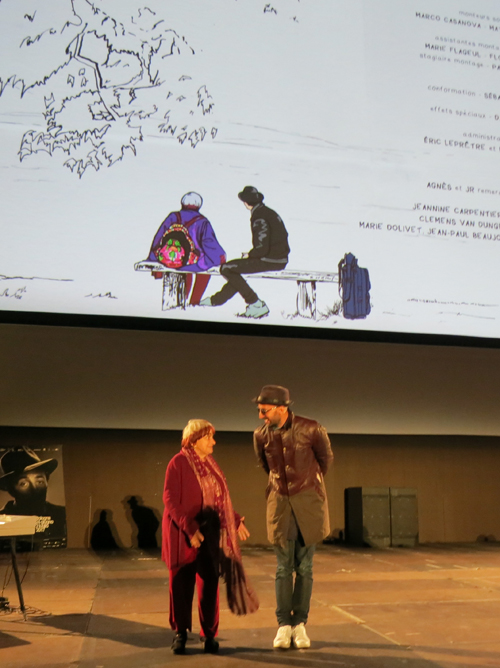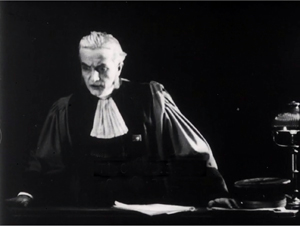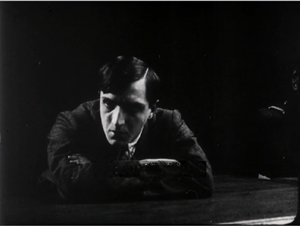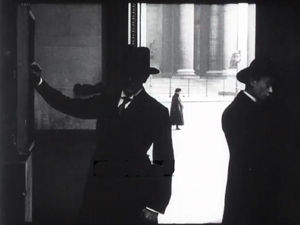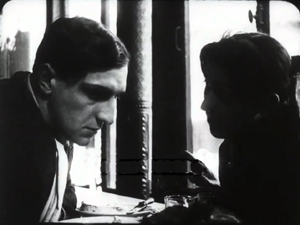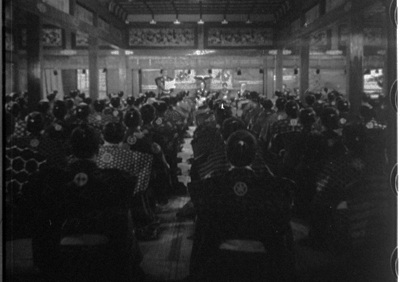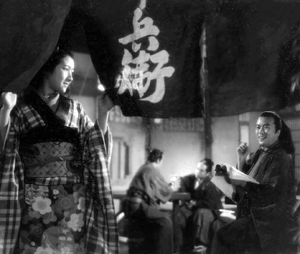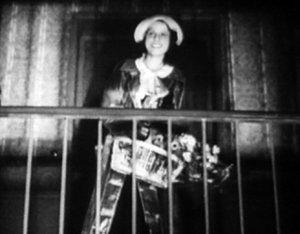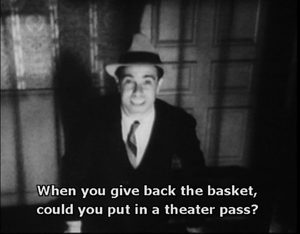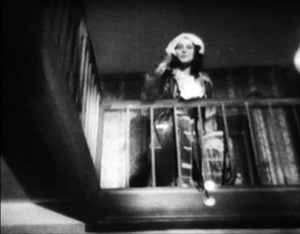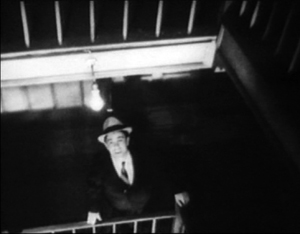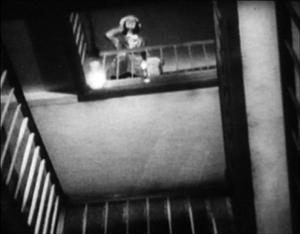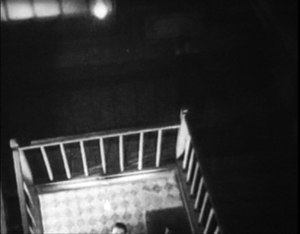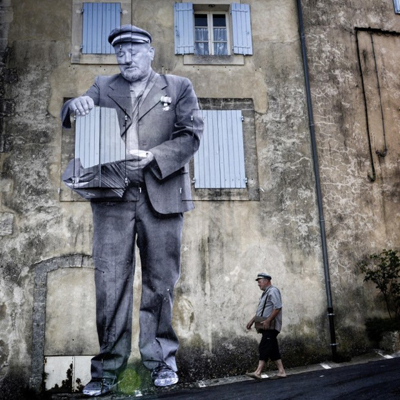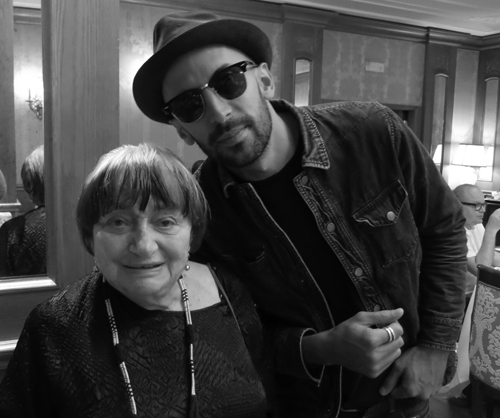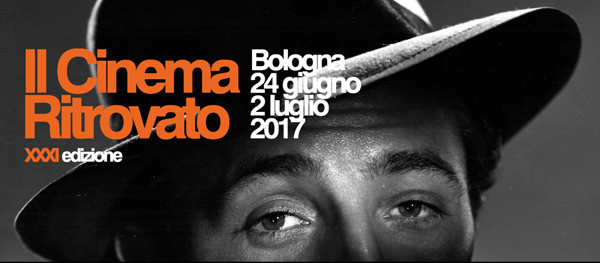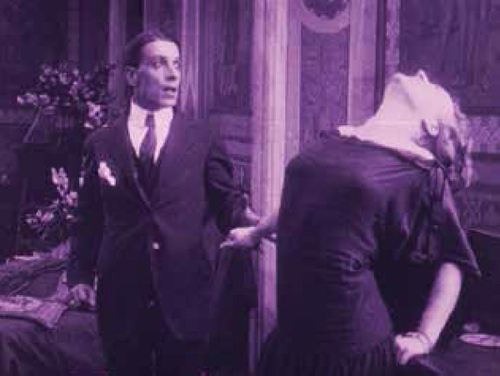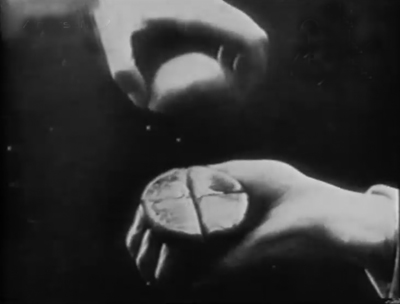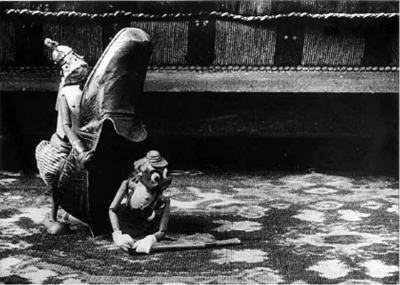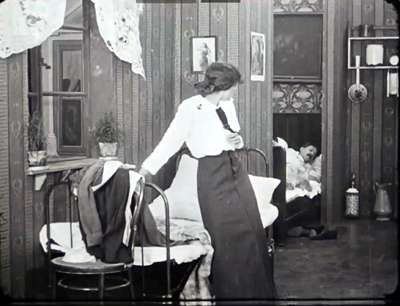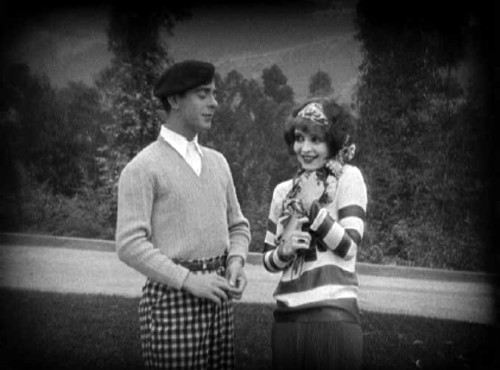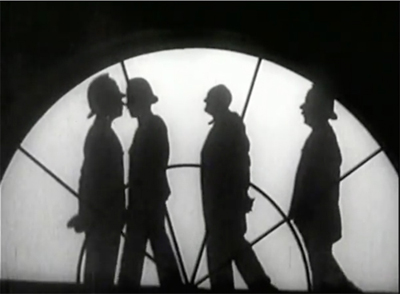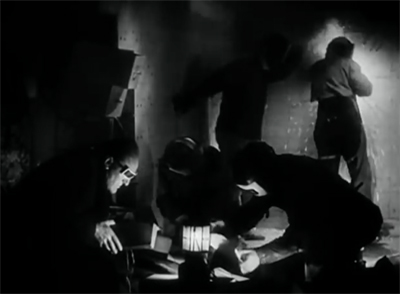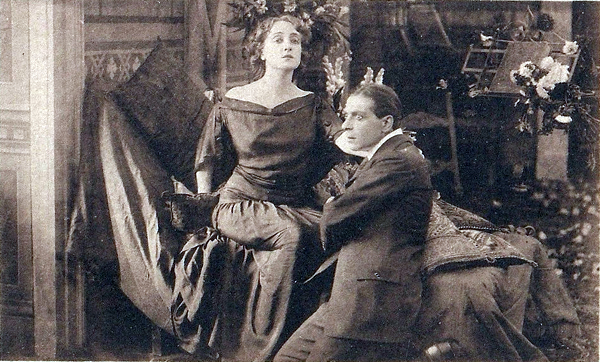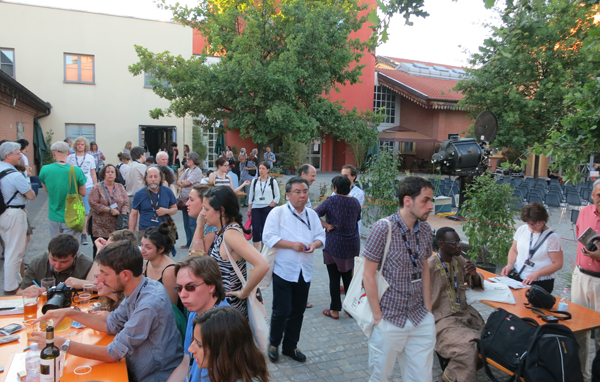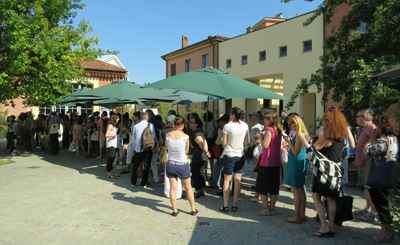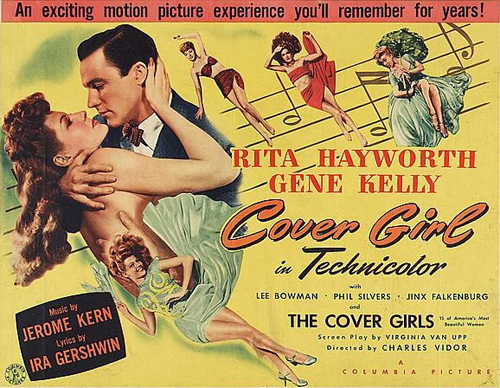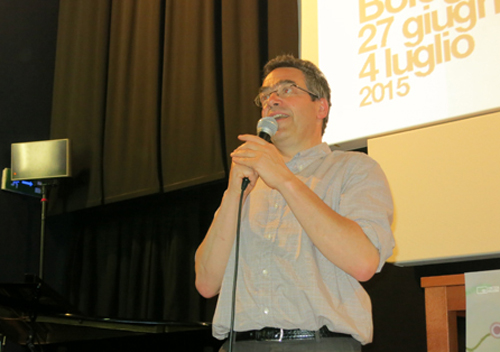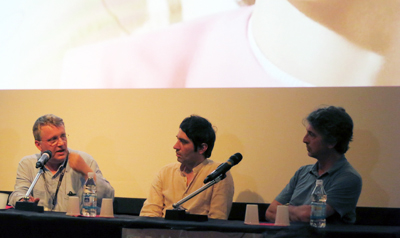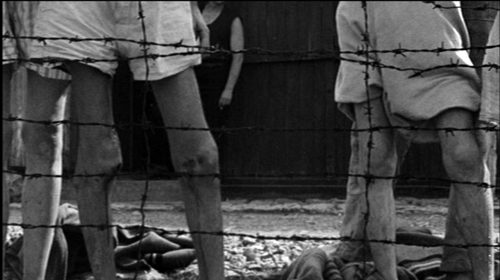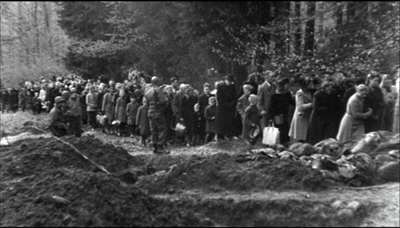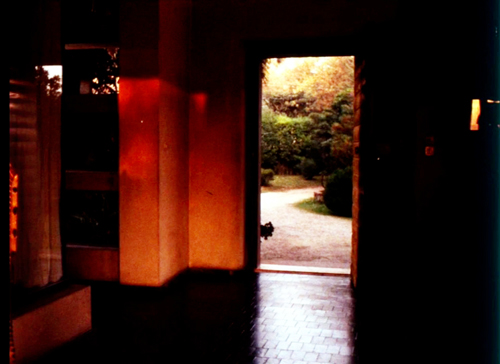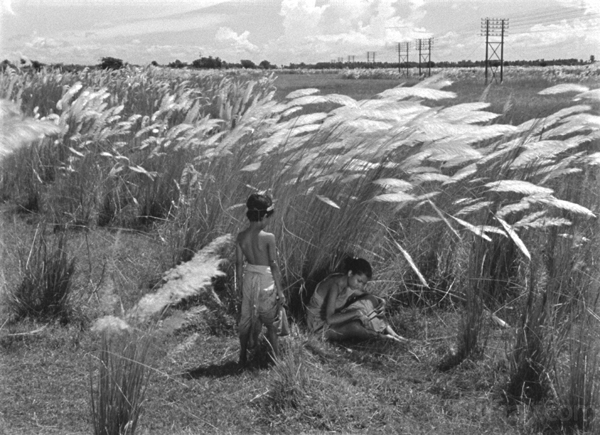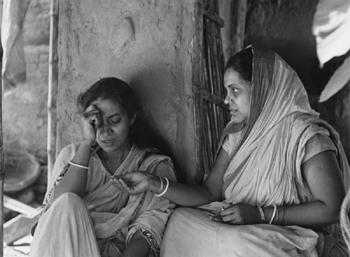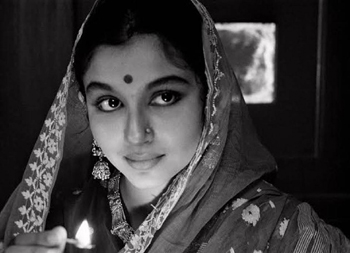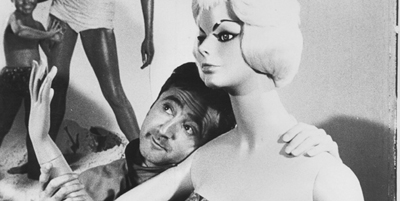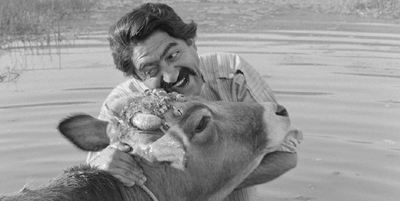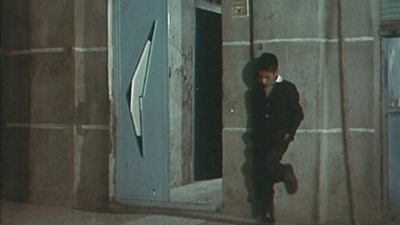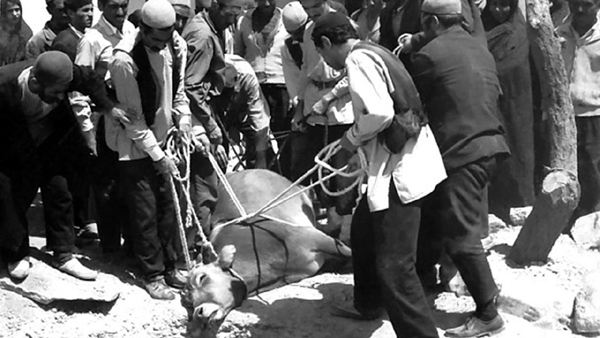Archive for the 'Festivals: Cinema Ritrovato' Category
Ritrovato 2017: Many faces, many places
Agnès Varda and JR, Il Cinema Ritrovato, 1 July. Photo: DB.
DB here:
This final post from Il Cinema Ritrovato is no less a miscellany than the others. With over 500 films screened, Kristin and I invariably missed things that others raved about. Still, we saw enough powerful cinema to make us want to flag some key items for you.
Silents, please
Kristin has already mentioned one of the most startling items we saw, Le Coupable (1917) by André Antoine. I’m still processing the audacity of this film. The prosecutor in a murder trial abruptly claims the defendant as his son. We then get the familiar flashback format, shifting from the courtroom to the events leading up to the crime and the arrest. But the shifts between present and past are so quick, and the bits we see of the trial are given in such intense, stark singles, that they gain an astonishingly modern pulse.
Add in marvelous use of locations, real alleys and corridors and cafes, and you have a very impressive movie.
Once more, 1917 proves to be dynamite.
From the same year came Furcht (Fear), by Robert Wiene. Count Grevin wanders anxiously through his castle for about sixteen minutes of screen time before we realize, thanks to a flashback, that he’s haunted by his theft of a precious Indian statue, stolen from a temple. Soon a priest materializes, either on the castle grounds or in Grevin’s imagination, to declare that he has only seven years to enjoy life before vengeance strikes. Which it does, of course. Conrad Veidt plays the priest with the smoldering glare, and ambitious superimpositions show how committed German cinema was to special effects. Dr. Caligari was three years off.
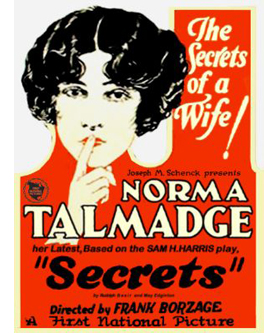 Not that other years should be slighted. Le Collier de la danseuse (The Dancer’s Necklace, 1912) was an agreeably preposterous crime movie. (The thief has a jacket with fake hands dangling from the sleeves, just the thing for escaping handcuffs.) The film boasted the low, almost Ozuesque, camera height typical of other Pathé productions of the year.
Not that other years should be slighted. Le Collier de la danseuse (The Dancer’s Necklace, 1912) was an agreeably preposterous crime movie. (The thief has a jacket with fake hands dangling from the sleeves, just the thing for escaping handcuffs.) The film boasted the low, almost Ozuesque, camera height typical of other Pathé productions of the year.
Borzage’s Secrets (1924) traces a marriage through three large flashbacks, with the first emphasizing romantic comedy, the second suspense, and the third family melodrama. Norma Talmadge, who savored a split-personality role in De Luxe Annie (1918), gets to play a woman at three ages here. The central section, devoted to a Griffithian siege on a lonely frontier cabin, showed Borzage’s ability to whip up enormous excitement, with an unexpectedly sad twist. The whole movie has over 11oo shots, indicating just how committed American filmmakers had become to fine-grained scene breakdowns.
All in all, the silent films on display this year were as revelatory as ever.
Cinematic geometries
The Abe Clan (1938).
For some years Ritrovato has included a Japanese sidebar curated by Alexander Jacoby and Johan Nordström. This year the theme was socially critical jidai-geki, or historical films. Some of them were fairly familiar to Western cinephiles because copies were circulated by the Japan Film Library Council from the 1970s onward. Examples include The Abe Clan (1938) and Fallen Blossoms (1938), both very good films. Along with these, the Bologna series gave the Yamanaka Sadao classic Humanity and Paper Balloons (1937) another well-deserved airing.
Some of these are fairly intimate dramas, others use a lot of spectacle. The image from Abe Clan above is fairly typical of the monumental turn some jidai-geki took in the late 1930s. Several of the films starred members of the left-wing Zenshinza kabuki troupe, perhaps best known to aficionados from Mizoguchi’s staggering Genroku Chushingura (1941-1942).
Three of the other films showed the range of this genre during Japan’s “dark valley,” its turn to authoritarian rule and imperial warfare. The Rise of Bandits (1937), by Takizawa Eisuke, was a rousing but melancholy Robin Hood tale. A lord’s honest son tries to save a shipment of gold from marauders, but he’s framed by his duplicitous brother. So he becomes the outlaws’ leader, at the cost of his wife’s life and his father’s trust. Some superb action sequences, including a fiery final assault on the castle, alternate with semicomic scenes among the bandits, with the hero’s cynical sidekick twisting not-too-bright thugs around his finger.
Hagiwara Ryo’s The Night Before (1939, production still above) was based on a Yamanaka script, and like Humanity and Paper Balloons, it braids together several characters’ fates. As rival samurai factions struggle during the Meiji restoration, ordinary people–an artist, a family running an inn, a young man wanting to make his name as a warrior, a bitter and disenchanted samurai–try to get by. One of the innkeeper’s daughters is attracted to the youth, another daughter who works as a geisha eyes the artist, and the old man seems to escape into endless games of shogi with a neighbor. The film has a panic-stricken climax, in which the factions collide in darkness along the riverside and innocents get swept up in the violence. As with many films in the series, the critique of mindless militarism isn’t far below the surface.
The Man Who Disappeared Yesterday (1941), by the great Masahiro Makino, is a murder mystery. An unpleasant landlord is the victim, and there are plenty of suspects. The scattered clues didn’t seem to me to play entirely fair, but the investigation is largely a pretext to explore adjacent households and obfuscate what turns out to be complicated post-murder maneuvers. At the climax, all the suspects are seated in a single line to hear the magistrate’s solution, just as if they were in Nero Wolfe’s office.
Makino’s style accentuates the spatial layout through a remarkable ten zoom-ins that yank us to one or another suspect as the explanation is given, sometimes with flashbacks. Camera zooms (as opposed to optical-printer ones, as in Citizen Kane) are rare in any national cinema of this period, and Makino uses them almost in the spirit of Hong Sangsoo, more to perk up our attention than to enlarge anything for closer scrutiny. (Admittedly, the last one rivets us on the guilty party.) The same geometrical impulse encloses the tale: an opening crane shot down, a closing one upward. As often in Japanese cinema, The Man Who Disappeared Yesterday marks and repeats film techniques to give a decorative flourish to the story.
Technique also comes to the fore, of course, in Divine (1935), a French production directed by Max Ophüls. The attraction isn’t just the dizzying camera movements, swimming through a tangle of backstage paraphernalia and crawling up stairways. Max is more than a master of the tracking shot. In one witty passage, framing and cutting coordinate to stretch the distance between a couple who can’t tear themselves away from each other. (In my last frame, the milkman’s head slides almost out of frame.)
The plot centers on a country girl who becomes a follies performer and is framed as a drug dealer by a Lothario and a lesbian. This contraption seems more or less a pretext for Ophüls to indulge his endless fascination with women striking poses for men while asserting their own demands. The abrupt and unexplained happy ending is the logical wrapup for a film less concerned with a plausible plot than a display of Woman in all her dazzling divinity. There. How’s that for a Sarris sentence?
Bigger than life
Although there were some repeats on Sunday, the final big event of the festival was the screening, to some 3000 people on the Piazza Maggiore, of the new film by Agnès Varda and JR. Kelley Conway reviewed its Cannes premiere for us earlier, and now that we’ve seen it, we like it a lot.
Varda has the ability to take a whimsical, borderline-cutesy idea and turn it into something poignant, as in Daguerreotypes and Opéra-mouffe. (Nursery-rhyming titles, like Mur Murs and Sans toit ni loi, encapsulate her attitude.) Her latest, an associational documentary along the lines of The Gleaners and I, depends on the premise of traveling through France and making enormous photographic portraits of ordinary people. These are then mounted on buildings in their home town–hence the title Visages Villages.
The result is both intimate and monumental. A postal clerk or a woman truck driver take on the billboard proportions of politicians and pop stars. Without any sense of slumming, Varda and JR can memorialize a woman living in a building about to be demolished, and can spare time for a haggard hermit who has dropped out of the system. It’s as powerful a populism as any you’ll see, but done with humor, genuine curiosity, and respect for the integrity of each subject. A playful approach to art can yield serious emotional effect.
As Visages Villages goes on, it turns introspective. Varda recalls episodes from her life and tries to incorporate one of her photos, a casual shot of Guy Bourdin, into a skewed tipsy WWII bunker rusting on a beach. She recalls young days with Godard and Karina, so that now when Godard dodges a meeting, she becomes rueful (“The rat!”). This lady gleaner is always gathering fragments, and we’re lucky she shares them with us.
Again Bologna gave excellent, overwhelming value. The surprises never stopped. Dropping into a film I hadn’t seen in three decades, Rancho Notorious, I not only had fun but realized once more Lang’s diabolical genius. A peculiar insert of a boot slipped into a stirrup puzzled me, but after an hour I got it. (Forgive me, Fritzie, for I knew not what I did.) Long may this festival flourish.
Thanks as ever to the vast and dedicated staff of Il Cinema Ritrovato, particularly Guy Borlée, Gian Luca Farinelli, and Mariann Lewinsky.
I discuss the trend toward monumental jidai-geki in chapters 12 and 15 of Poetics of Cinema. More detailed analysis can be found in Darrell William Davis’s book Picturing Japaneseness: Monumental Style, National Identity, Japanese Cinema.
Visages Villages (aka Faces, Places) is distributed by the Cohen Media Group.
Agnés Varda and JR. Photo: DB.
Ritrovato 2017: Drinking from the firehose
DB here:
Immense scale and teeming activity are nothing new to Il Cinema Ritrovato, the Cineteca di Bologna’s annual jamboree of restored and rediscovered films from all over the world. The scorching heat–90 degrees and more for the first few days–only makes it seem more intense than usual.
Kristin and I had to miss the last Ritrovato session, but we’re convinced that this nine days’ wonder is still the film-history equivalent of Cannes.
In one way, your choice is simple. You can follow one or two threads–say, the Robert Mitchum retrospective or the Collette and cinema one or the classic Mexican one, or whatever–and dig deep into that. Or you can skip among many, sampling several, smorgasbord-style.
In practice, I think most Ritrovatoians pursue a mixed strategy. Settle down one day for a string of, say, early Universal talkies and another day check out the restored color items. On off-days roam freely. The problem is you will always, always miss something you would otherwise kill to see.
At the start, I plumped for 1910s films, particularly Mariann Lewinsky’s reliable 100 Years Ago cycle. My other must was the Japanese films from the 1930s; half of the titles brought by Alexander Jacoby and Johan Nordström, were new to me. As of this writing, I haven’t seen those, but I have dug into the 1917 items. And I indulged myself with, no surprise, some gorgeous Hollywood things.
1917 and all that
Malombra (1917).
If you caught any of my dispatches from Washington DC earlier this year (starting here) you know I was burrowing deep into American features of the 1910s That complemented several years of archival work on European films of the same period. So of course the chance to sample 1917 features from Hungary, Poland, Russia, and elsewhere was not to be passed up.
Some superb ‘teens films I just skipped through familiarity. Gance’s Mater Dolorosa (1917), possibly the most patriarchal film in the thread, remains tremendously inventive at the level of silhouette lighting and continuity cutting (a huge variety of camera setups during the fatal love tryst). And one of the very greatest directors of the period, Yegenii Bauer, was represented by two of his last films, The Revolutionary and Towards Happiness. I’ve studied both elsewhere, in On the History of Film Style, Figures Traced in Light, and online. Even so, I found plenty to keep me busy.
One of the main threads was devoted to Augusto Genina, a director with an astonishingly long and prolific career. Probably best known for Prix de Beauté (Miss Europe, 1930), he started in 1913 and made his last film in 1955. His 1910s films confirm that Italy was producing many films of striking beauty and audacity in those years.
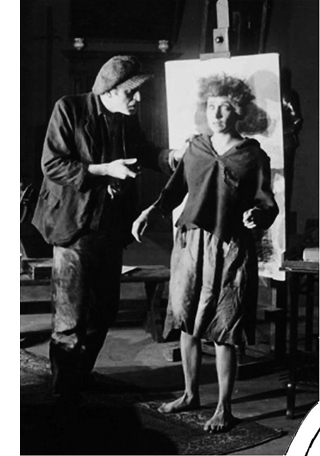 Take Lucciola (1917, right), the story of a waif who befriends a harbor layabout but leaves him to become a society princess admired by a debonair painter and three bulbous plutocrats. Pivoting from social satire to low-life melodrama, the film makes use of bold lighting and meticulous cutting, usually along the lens axis. (Like many European films of the ‘teens, Lucciola lies sort of between tableau cinema and the faster-cut American style.) All in all, a strong, tight movie.
Take Lucciola (1917, right), the story of a waif who befriends a harbor layabout but leaves him to become a society princess admired by a debonair painter and three bulbous plutocrats. Pivoting from social satire to low-life melodrama, the film makes use of bold lighting and meticulous cutting, usually along the lens axis. (Like many European films of the ‘teens, Lucciola lies sort of between tableau cinema and the faster-cut American style.) All in all, a strong, tight movie.
In a similar vein is Addio, Giovenezza! (1918), adapted from a popular song. This one, screened in an open-air venue thanks to an arc-lamp projector, is another sad Genina tale. A careerist law student abandons his rooming-house maid for a social butterfly with a wardrobe to die for. Apart from one startling scene in a milliner’s shop, illuminated mostly by spill from the street, the lighting isn’t as daring as in Lucciola. Still, the poignant plot is again inflected by comic touches, proceeding largely from the hero’s nerdish fellow student. Genina redid the story again in 1927, and I’m hoping to catch that screening.
Malombra (1917), starring the diva Lyda Borelli, was by the great Carmine Gallone. (I’ve discussed La Donna nuda and Maman poupée hereabouts.) After moving into a castle, Marina becomes possessed by the spirit of the woman who died there. Our heroine’s job is to take revenge on the faithless husband. Flirtatious and iron-willed, Borelli dominates her scenes with shifts of stance, sudden freezes, rapid changes of expression, languorous arm movements, and, at one climax, a swift undoing of her hair that lets it all tumble wildly around her face. The print, needless to say, was superb.
In a lighter vein, if you wanted proof of the inventiveness of ‘teens Italian film, you couldn’t do better than Wives and Oranges (Le Mogli e le arance; 1917). This agreeably silly movie sends a bored young man to a spa populated by incredibly aged parents and a bevy of scampering daughters. With an avuncular friend, Marcello capers with the girls before settling on the most modest one as his wife. But her friends aren’t disappointed because our hero’s pals come for a visit and get roped into matrimony too.
Wives and Oranges has a remarkable freedom of narration. The film uses montage sequences with a fluidity that is rare at the time. To convey the boredom of Marcello’s daily routine, a string of quick shots is punctuated by changing clock faces. Later, the idea of finding one’s ideal love mate by matching halves of oranges is presented via an absurd montage of old folks, youngsters, babies, and just abstract hands, all wielding oranges.
Marcello’s paralyzing dilemma of choice is given as a nondiegetic insert of a donkey unable to decide between a hay bale and a bucket of water. These flashy devices keep us interested in a situation that, in script terms, is probably stretched too thin–although when things slow down you can count on the daughters forming a chorus line and zigzagging down the road or popping out from under the dinner table one by one.
Almost as lightweight was The War and Momi’s Dream (La Guerra e il sogno di Momi, 1917), by the great Segundo de Chomón, who moved among France, Spain, and Italy making fantasy films of many types. This one is largely meticulous puppet animation, in which a boy’s toys come to life and enact–at the height of the World War–their own combat.
Trick and Track marshall other toys to play out some seriocomic clashes, including a burning farmhouse and one astonishing shot of an entire town landscape, covered in a long camera movement. Again, there’s no underestimating the sheer technical audacity of Italian cinema of these days.
There’s always an exception, of course. The late David Shepard left us, among much else, Shepard’s Law of Film Survival: The better the print, the worse the movie. A good example is La Tragica fine di Caligula Imperator (1917), signed by Ugo Falena. It’s surprisingly retrograde for an Italian film of the period. Neither the staging (flat, distant) nor the cutting (minimal) nor the lighting (little modeling) is much in tune with contemporary norms. The problem may be the immense sets, which are indeed impressive but which seem to encourage the actors to a hard-sell technique.
The most amped-up is Caligula himself. Playing a mad Roman emperor often tempts any actor to gnaw table legs. But as an example of what a silent film really could look like, Caligula should be required viewing for anybody who sneers at Those Old Movies. If Christopher Nolan saw it, he’d demand to shoot on orthochrome nitrate.
Other 1917 features included The Soldier on Leave, from Hungary, and Stop Shedding Blood!, by the great Russian director Jakov Protazanov. The former was restored from a 17.5mm copy, the latter was missing the two central reels. The Protazanov in particular had some sharp staging in depth and rich sets.
In the same batch was Pola Negri’s screen debut in Bestia (1917, imported to the US as The Polish Dancer). In a fine copy, you could appreciate the bouncy but sultry screen presence that made her a star. And as often happens with films from anywhere in this period, the sets sometimes play peekaboo with the action. Pola, after a night out with her thuggish lover, sneaks back to her bed while her father snores in the background, caught in a slice of space.
Back in the USA
Kid Boots (1917).
The 1917 American entry was a strong, unpretentious Western by Frank Borzage, Until They Get Me. It’s missing some scenes in the middle, but it remains a forcefully quiet movie. The only gunplay takes place at the start, when a man racing to get to his wife in childbirth is forced into a gunfight. He kills the drunkard who provoked it, but by the time he reaches his home, his wife is dead. Now he must flee Selwyn, a mountie. Stealing a horse, he picks up an orphan girl fleeing an oppressive household. The rest of the film will intertwine the fates of the three, leading to a surprisingly civilized resolution.
Borzage is one of the many great directors–De Mille, Dwan, Walsh, Ford, Brown, King, Barker–who started doing features in the mid-teens. Most had long careers. They mastered the emerging norms of Hollywood continuity cinema and learned to deploy them with tact and precision. Just the timing of the reaction shots in Until They Get Me is worth study.
Frank Tuttle started in features a bit later, in 1922, but Kid Boots (1926), my first movie of the Ritrovato, showed complete mastery of comic storytelling. Eddie Cantor, a fired tailor, becomes amanuensis to Tom Sterling, a man-about-town in the throes of a divorce. The twist is that his wife, learning of Tom’s new inheritance, wants to halt the divorce by sharing his bed again. Eddie’s job is to keep the wife and the lawyers at bay until the divorce becomes final. Into this tangle plops perky Clara Bow in her first film after her breakout role in Mantrap (also 1926). You could watch her cock her chin and roll her eyes for hours. She steals the picture from Billie Dove.
The gag situations come thick and fast, with one high point being Eddie’s efforts to get Clara jealous by recruiting a strategically open door to help him pretend that his left arm actually belongs to Tom’s seductive wife. The whole thing culminates in a breathless chase on horses along a treacherous mountain pass. Eddie and all the others keep things lively, and Tuttle’s direction is exacting.
I strayed from the ‘teens again at Dave Kehr’s urging. Of Dave’s magnificent MoMA restorations, I caught William K. Howard’s Sherlock Holmes (1932). Apart from a wild-eyed Ernest Thesiger and an imperturbable Clive Brook, it boasts an abstract opening of silhouettes and confrontational close-ups and a conclusion of percussive flashes as Moriarty’s gang torches its way into a bank.
Ace cinematographer George Barnes had a field day with this one.
That was followed by Tay Garnett’s Destination Unknown (1933), a tense drama of a crisis on a bootlegging ship immobile on a windless sea. Hard, fast playing by Pat O’Brien and Alan Hale was offset by the leisurely presence of none other than Ralph Bellamy, aka Jesus of Nazareth. Don’t ask; just see it.
More from me, and Kristin, later in the week.
Thanks to Guy Borlée for a great deal of assistance on this entry. Thanks as well to the programmers and staff of the festival, especially Gian Luca Farinelli and Mariann Lewinsky.
The Ritrovato site is constantly updated. For our earlier Ritrovato communiqués, go here.
Malombra (1917; production still).
Il Cinema Ritrovato: A final entry
The courtyard outside the Cineteca di Bologna, during Il Cinema Ritrovato.
DB here:
Some initial figures are in, and they’re fairly stupendous.
There were about 85,000 admissions to all screenings of this year’s Cinema Ritrovato, which ended ten days ago. That figure includes the big public shows on the Piazza Maggiore, but the day-in, day-out screenings were heavily attended as well. There were 2500 or so festival passes sold. Assuming that those people stayed for four of the festival’s eight days and attended four shows a day, we can surmise that at a minimum 40,000 of overall admissions came from dedicated cinephiles surging from venue to venue. And of course many passholders stayed seven or eight days and squeezed in more than four viewings on each one.
Broiling heat—one day approached 100 degrees Fahrenheit—didn’t seem to keep many away from the films, panels, book talks, and other events that crowded the schedule. Between 9 AM and 1 PM, each two-hour block offered six to eight choices, and the afternoon blocks, running from 2:30 to about 8 PM offered even more. Now that the festival has another space, a nearby university auditorium fitted for DCP projection, a whole new column of events was slotted in. Below, a bit of the queue for the Isabella Rossellini interview in the auditorium.
Next year, planners are hoping to add screenings at a renovated 100-year-old theatre on the Maggiore. There seems no doubt that the Cannes of Classic Cinema will get even bigger.
For the first time, I felt the pace was a bit rushed. Getting together with old friends was somewhat harder than before, unless you came a day or so early. (Even then, there were tempting Maggiore evening shows.) But the atmosphere was still easygoing. The courtyard of the Cineteca was an island of steamy relaxation, boasting more tables than in past years. The tent cafe provided snacks and drinks for those who simply decided not to be obsessive. Even I stopped and sat down, twice.
Word is out. A new wave of young film lovers has discovered Ritrovato. What had been dominated by hip (or hip-replaced) baby boomers was now teeming with students. The festival has added a Kids section and another devoted to older teens, and it was a pleasure to see them winding through the corridors of the Cineteca. The World Press has finally woken up too. The Guardian ran a rapturous encomium. Loyal blog sites such as Photogénie provided extensive coverage.
Just speaking for us, this was the first year Kristin and I had almost no time to blog during the event. Hence this, the last of our catch-up entries. (Click back for the earlier ones.) And I will leave out a lot.
All in favor of film, raise your hands
Has everything been said about digital cinema and its differences from photochemical cinema? Maybe so. Nonetheless, the two panels I visited on the subject raised a lot of intriguing points, in quite different formats.
The first session compared 35mm prints with digital restorations. Through clever maneuvering, the Ritrovato boffins were able to switch back and forth between versions as both were running, and the results were pretty compelling. Schawn Belston of Twentieth Century Fox provided a sample of Warlock, a twenty-year old print. It was contrasty but had saturated color; this was the sort of image I remember seeing in theatres. The digital restoration, a work in progress, was paler, with sharper edges, more solid-black shadows, and a more pastel color design. Pretty Poison was a much newer print, on Vision stock, and looked fine, as did the DCP.
Grover Crisp of Sony brought a Kubrick-approved print of Dr. Strangelove, considered best-quality in 1990s. He ran it in tandem with the recent 4K restoration managed by Cineric. The difference was very striking. For black-and-white, at least, the DCP seemed to me to have all the better of it. Kubrick, a major otaku on matters photographic, would I think have approved.
Further proof of the Crisp-Sony finesse was available in the utterly dazzling DCP we saw of Cover Girl (1944) on the big Arlecchino screen. I was surprised to find some of my circle disdaining this movie, but I think it’s wonderful. It seems to me a rough draft for many of Gene Kelly’s MGM pictures, from the trio boy-girl-stooge we get in Singin’ in the Rain (with Phil Silvers as Donald O’Connor) to the mind-bending doppelganger dance that looks forward to Anchors Aweigh and Jerry the Mouse. I also like the clever motifs of feet and faces, and the flashbacks, and …well, I must stop, because I expect to use Cover Girl as a major example in my still-unfinished book on Hollywood in the 1940s. Suffice it to say that I have never seen a better DCP rendering of Technicolor than was on display in Grover’s new edition.
Davide Pozzi rounded out the session with a pairwise comparison of different versions of Rocco and His Brothers. A vintage print from the camera negative had been vinegared, so the shots had rippling focus; the DCP restoration was fairly sharp and bright. This was a real work of reclamation.
The panelists agreed on a lot. Don’t try to banish grain; film is grainy. Don’t expect to match everything. No two prints ever looked alike anyhow, and variations among screens, lamps, and other exhibition factors don’t let us capture a pristine original experience. Because of the advances of digital restoration, there are new frustrations. Archivists are aware that older restorations may not look good today, while cinephiles who forgive scratches on “vintage” 35mm copies howl if a restoration doesn’t look smooth as silk.
Film has many futures. Pick one.
Serge Bromberg introducing the Lobster Films anniversary program, which included several “faux Lumières.”
Another panel, “The Future of Film” (let’s ban this as a title, shall we?), was less focused but more provocative. No fewer than fifteen critics, archivists, manufacturers, and filmmakers gathered before a standing-room crowd to discuss the prospects for the photochemical medium formerly known as film.
The panel’s speakers worked in shifts, three at a time. Everybody was lucid and brief. Some general points:
On the manufacturing front, Kodak and Orwo are committed to producing motion-picture stock. Christian Richter of Kodak noted that in 2006 his firm produced 11.8 billion feet of motion-picture film, while last year it produced only 450 million feet. The demand may be plateauing, but it’s too soon to be sure. The crucial problem may be the absence of labs, although boutique labs are starting to appear.
Some filmmakers, such as Gabe Klinger, consider film an essential part of their aesthetic. Alexander Payne prefers to shoot on film, but more important is film projection. He restated his view that “flicker will always be superior to glow.” By contrast, archivist Grover Crisp proposed that the standard of film projection had sunk so low that he prefers to see digital presentations, although those too can be substandard.
Some archives are preserving on film recent movies, including those shot digitally. Sony does, as does the CNC. Eric Le Roy reported that all French films receiving subsidy must deposit a print and the negative there, even if the project originated digitally. Mike Pogorzelski of the Academy archive spoke of the ongoing “Film to Film” effort, begun in 2012.
More generally, two archivists argued that the future of film lay in museums. José Manuel Costa of the Portuguese film archive argued that the basic principle had to be a respect for the nature of the medium. Cinema has changed, but it has existed in a specific technological environment since the nineteenth century, and it’s the mission of a film museum to retain that technology as long as possible. Accordingly, a film should be shown in the format in which it was made.
Belgian film archivist Nicola Mazzanti (on left above, with Pietro Marcello and Alexander Payne) seemed in accord. He remarked, in the wake of the earlier session, that digital treatment, or film restoration generally, can’t duplicate tinting, toning, stencil color, Technicolor, and other older processes. The originals are what they are—imperfect—but that imperfection is inherent in their material history. More acutely, the world outside the archive is entirely digital, so it will be a big task to keep analog alive. It will take money. And no European archive’s budget equals the cost of a single season of La Scala.
Scott Foundas, who chaired the sessions with easy good humor, indicated that perhaps the state of play was this. Digital capture and storage would not wholly replace film. By now film is recognized as distinct and worth its own attention. It’s going to exist alongside digital media for some time to come, although in niches and in more rarefied forms than before; like vinyl records.
Bologna, it became clear, is one of those places where film will continue to flourish. Fifty percent of screenings this year were analog, and the programmers included showings of Vertigo, The Heroes of Telemark, All That Heaven Allows, and other titles on “vintage” prints from earlier eras. Audiences packed in to see them and cheered.
What they saw, we must see
With all the talk of film’s enduring powers, two screenings reminded me of the power of photochemical recording as a record of history, both en masse and individual.
German Concentration Camps Factual Survey was overseen by Sidney Bernstein and involved several skilled filmmakers, including Hitchcock. It was designed to be shown to the German people as a record of what they had ignored over the last dozen years. But it remained unfinished when it was shelved in 1945.
In recent years the surviving reels have been shown occasionally under the title Memory of the Camps. In 2008 several staff at London’s Imperial War Museum began to restore the original and fill out the final reel. The filmmakers added a new recording of the original commentary, previously not attached to the footage.
Friends of Andy Warhol often commented that he used his ever-present Polaroid to keep his distance from his surroundings. You wonder if a similar strategy didn’t insulate, to some minimal degree, the American, British, and Russian cameramen who filmed the liberation of the camps. Their images show shriveled corpses covering the ground, flung into pits, shoveled into heaps. Spindly survivors move like ghostly marionettes. When I saw the first images of the bland camp officials smoking and chatting under guard, I immediately wondered: What self-control it must have taken not to have killed these men on sight.
The film is structured as a sort of anti-Grand Tour, starting in Bergen-Belsen, where SS officers seem genuinely annoyed at being forced to clear out the dead. The film moves eastward, guiding us by maps, to end in the abandoned Nazi extermination camps built in German-occupied Poland. Here shoe brushes, spectacles, and children’s toys fill warehouses. The names of German companies proudly adorn ovens.
One of the film’s main points, apparently suggested by Hitchcock, is the fact that the camps existed very close to population centers. Did the people celebrating Oktoberfest in Munich ever think of Dachau, half an hour away by train? Did the people breathing the mountain air of Ebensee spare a thought for the camp nearby? Arriving Allies insisted that people from surrounding towns be brought to witness what they had ignored. In the footage, men, women, and children file by the carnage.
Some seem moved, but eerie shots show town elders standing stiff and impassive before heaps of bodies.
Toby Haggith, one of the film’s restorers, was on hand for a follow-up session, something really demanded by the intensity of the experience. He answered questions with great seriousness and eloquence. He explained that the restoration team had decided to leave in the film’s original errors, based on contemporary reports of the size or uses of certain camps, as well as the film’s avoidance of focusing on Jewish victims. The film stresses the Nazis’ crimes against humanity at large, an emphasis, as Haggith pointed out, in tune with the United Nations initiative of the moment. “The very historicity of the film is what seizes us.”
Godard has suggested that there must be footage of the day-to-day running of the camps. Would the society that devised Agfa film and Arriflex cameras have failed to document the industrial-scale slaughter of which the Reich was so proud? Were there no amateur cineastes among the SS-men leading comfortable lives in their cottages? Was there no Leni Riefenstahl to cheerfully lend credibility to these charnel houses? Even if such footage exists, German Concentration Camps Factual Survey will serve as an unforgettable reminder that humans have a terrifying gift for brutality, and for ignoring horrors enacted right beside them.
Many doubts, much faith
Visita ou Memórias e Confissões.
In 1982, financial setbacks forced the Portuguese director Manoel de Oliveira to sell the house he had lived in for forty years. Before leaving, he decided to record his affection for the place. The result, Visita ou Memórias e Confissões was the quietest film I saw at Ritrovato. It was also one of the best.
We start at the gateway, coming in as if guests. But who owns the voices we hear? The murmuring man and woman who seem to be our surrogates passing along the path? We never see them as they enter the magnificently curvilinear house. But is it right to say they? Although we hear two voices, we hear only one person’s footsteps. The somewhat whimsical uncertainty that haunts so many Oliveira films is summoned up here by the simplest of means.
Eventually Oliveira greets us, standing in his study before his typewriter, and he explains some of the house’s history. He also runs some footage on a 16mm projector that coaxes him into discussing death, women, virginity, and sanctity. “I’m a man of many doubts and much faith.” Occasionally we hear the couple whispering as we coast past art objects and family pictures.
Oliveira tells us of his 1963 arrest while making Rite of Spring and his 1974 conflict with workers in his family’s factory—a tumultuous event that, we learn rather late, is the cause of his financial distress. These revelations come in the midst of a fascinating account of his family, accompanied by a tribute to his wife, to whom the film is dedicated. Individual history and social history blend in his recollections and the flow of visual memorabilia.
The spectral visitors glide out with us, and the film that Oliveira has been showing halts, leaving us a blaring white frame. According to his wishes, Visita wasn’t shown until after his death. Perhaps in 1982 he expected that event to come rather soon; he was seventy-three, after all.
He couldn’t have known, surely, that he would live another thirty-three years and make twenty-four more films. As José Manuel Costa pointed out, the great director wanted the film to be shown posthumously not as a final boast, but rather a wry, modest memoir of an exceptionally full life. By turns ironic and confessional, Oliveira’s testament demonstrates that we can be moved by a soft-spoken, patient peeling back of layers of the past.
Of course it was shown on film.
Kristin and I thank the many staff members who make Ritrovato such a wonderful experience. Special thanks to Gian Luca Farinelli, Guy Borlée, and Cecilia Cenciarelli. We are particularly grateful to Marcella Natale for her many moments of assistance, including giving us preliminary attendance figures.
German Concentration Camps Factual Survey will play several film festivals and public venues during the rest of the year and will eventually be distributed on DVD. Night Will Fall (2014), André Singer’s documentary on the making and restoration of the original film, is already available.
P.S. 31 July: Danny Kasman has an illuminating interview with Toby Haggith on the Factual Survey, along with important background information, at Cineaste.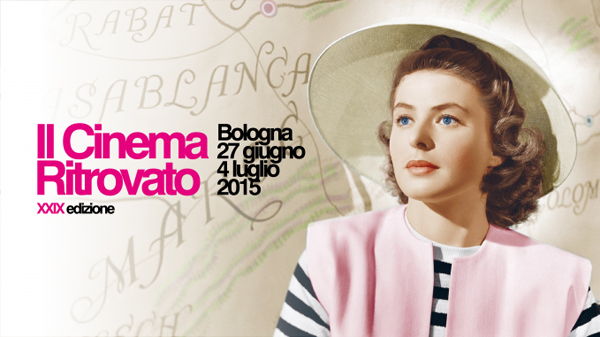
Il Cinema Ritrovato: revelations from India and Iran
Pather Panchali
Kristin here:
The second half of my week at the Cinema Ritrovato festival in Bologna was centered around two Asian events: a small program of Iranian films from the 1960s and 1970s and the restored Apu trilogy. In between those screenings I tried to fit in some programs of pre-1920s cinema.
Bringing the Apu Trilogy back from the ashes
That was the title of a panel presentation during the festival, one which I missed because I was watching the first of the four Iranian films. In this case the metaphor is literal. The original negatives of the Apu films were stored in a London warehouse, and in 1993 a fire damaged them extensively.
In 2013, The Criterion Collection and the Academy of Motion Picture Arts and Sciences began a collaborative restoration. Working meticulously by hand and employing an innovative rehydration technique, experts at L’Immagine Ritrovata in Bologna rescued the images for about 40 percent of Pather Panchali and 60 percent of Aparajito. The negative of Apu Sansar (The World of Apu) was wholly lost. For it and the missing parts of the other two films, footage from fine-grained masters and duplicate negatives from various archives was used. The restoration was done in 4K. (For an interview with Lee Kline, Criterion’s technical director, see here. There is a short but informative short film on the restoration, including some before-and-after comparisons, on Vimeo.)
The result is spectacular, far better than one would expect, given the dire circumstances the restorers faced. It was a privilege to see the entire trilogy over three days on the huge screen of the Cinema Arlecchino from the front row. There were times when the replacement footage was obvious, but for the most part, the images look pristine. They also look like film, with no hint of video-y quality about them.
I had seen the trilogy only once, in 16mm back in my graduate-school days. At the time, I admired it but wasn’t bowled over. Sitting through the Ritrovato screenings, I found it a profoundly moving and beautiful experience. Satyajit Ray manages both to maintain a quiet, leisurely pace and to compress the hero’s life, from birth to early adulthood, into three parts totalling less than six hours.
Apu’s strict but devoted mother (below left, in Aparajito) anchors the first two films, gaining our sympathy despite her scolding and worrying. Apu’s wife, Apurna (below right, in Apu Sansar), is in the third film for a remarkably short time. Yet we quickly come to understand her love for this unknown man whom she marries almost by accident, her sense of humor, and her compassion, all of which are vital to our sympathy for Apu’s utter devastation after her death. Indeed, the trilogy involves five major deaths, all of which makes the hopeful ending the more affecting.
Presumably The Criterion Collection will bring out a Blu-ray set of the three films, though no date has yet been announced.
Iran’s own New Wave
Admirers of Abbas Kiarostami, Mohsen Makhmalbaf, Asghar Farhadi, Jafar Panahi, and other notable directors of the Iranian cinema of the past few decades might be curious about their forerunners. Iranian film critic and historian Ehsan Khoshbakht has begun to satisfy that curiosity by programing a short series of classics of pre-Revolutionary cinema. According to his program notes (available in their entirety online), the four films shown in Bologna constitute about a quarter of the output of the Iranian New Wave. I hope there will be further screenings at future festivals.
As Khoshbakht warned in introducing the earliest film in the series, Shab-e Ghuzi (Night of the Hunchback, 1965), it is not a masterpiece and certainly not a forerunner of the filmmaking that would later bring Iran to prominence in international festivals and art cinema. Director Farrokh Ghaffari was a pioneer of Iranian filmmaking beginning in the 1950s, but he is perhaps equally important in having started the first Iranian film archive.
Night of the Hunchback is a black comedy with a story loosely derived from The Trouble with Harry. A player in a cheap entertainment troupe is accidentally killed, and the bulk of the film follows his corpse as it is passed from one group of characters to another; these include a pair of smugglers running a beauty salon, who provide much of the film’s humor (above). Most try to dispose of it, but a society woman trails it in the hope of retrieving an incriminating document in its jacket pocket. By Western standards it seems like a fairly mainstream commercial work, but it departed from commercial Iranian cinema, according to Khoshbakht, “with its respect for folklore and its bitter portrayal of the upper class.” It was a commercial flop but gained some attention at European film festivals.
The most famous film of the era is Gaav (The Cow, dir. Dariush Mehrjui, 1969). It centers around Hassan, the owner of his village’s sole cow. He dotes on the beast, as is quickly established in an early scene when he affectionately bathes her.
When the cow mysteriously dies (a cause is hinted at but never confirmed), the villages lament the loss of their only source of milk, but they also worry about how Hassan will react when he hears the news.
Although Hassan is the evident protagonist of the film, the drama centers more around the ignorance, lack of judgment, and even cruelty of the villagers. The film begins not by introducing Hassan and his cow but with a disturbing scene of the local children chasing and tormenting a mentally defective young man. This establishes the tone for several later scenes.
When the cow’s death is discovered, the small group of men who wield authority initially concoct a story of the cow having run away, and the villagers bury the carcass (bottom). As Hassan descends slowly into madness, the people supposedly trying to help him make every possible wrong decision, leading to disaster.
If the films I discussed in my previous entry extolled the virtues of village life and represented leaving home as unwise, The Cow is just the opposite. Cut off from the outer world, the villagers have little education or ability to come up with logical solutions to problems. It’s a theme repeated in the other two Iranian fiction films on the program as well.
Yek Ettefagh-e sadeh (A Simple Event, dir. Shrab Sahid Saless, 1973), the latest of the films shown, seems the most obvious forerunner of the wave of Iranian cinema that started in the 1980s. It closely follows the daily routine of a young, unnamed boy living in a small town on the edge of the Caspian Sea. We see him at school, helping sell the few fish that his father catches each day, eating and trying to study in the almost unfurnished house he shares with his father and sickly mother.
There’s little dialogue, apart from scenes in the school. I believe the boy speaks two lines in the entire film, and his father communicates with him only occasionally, to order him around: “Close the door” or “Study.” Much of the action consists of the boy running through the streets on errands, including his night-time visit to fetch a doctor for his ailing mother (below).
Although there’s a superficial resemblance between A Simple Event and the later films of the “child quest” genre, I see considerable differences as well. In films like Kiarostami’s Where Is My Friend’s Home? or Panahi’s The Mirror, the child protagonists have clear-cut goals which they have decided upon themselves. They are stubborn and determined, and as they doggedly pursue their goals we are never unsure about their motives.
In A Simple Event the boy has no goal, and we learn almost nothing about his character. Is he really as stupid as his teacher believes, or is he behind his classmates because he gets little chance to do his homework? Does he love his mother or is he indifferent to her declining health? Is he resentful but cowed by his elders? Or is he resigned and accepting of his lot? We have no way of knowing. His one independent action is to buy a bottle of Coca-Cola to go with his usual meager meal after his father uncharacteristically gives him a little money.
There’s certainly a suggestion, once again, that small-town life is deadening to people. The rote learning and lack of relevance in the subjects taught in school help explain the lack of imagination and the resignation to their situation among the students.
My suspicion is that later directors may have seen the potential in A Simple Event and built upon it, introducing a greater empathy with their child protagonists and certain greater drama and suspense.
To me, the surprise among the Iranian films was Oon Shab Ke Baroon Oomad Ya Hemase-Ye Roosta Zade-ye Gorgani (The Night It Rained or the Epic of the Gorgan Village Boy, dir. Kamran Shirdel, 1967). It’s a 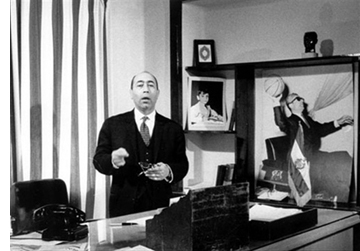 sophisticated investigative documentary that reminded me of the work of Erroll Morris.
sophisticated investigative documentary that reminded me of the work of Erroll Morris.
The film begins with a written report on the making of the film itself, submitted to the authorities by Shirdel. It seems to describe earnest attempts to document an inspiring story that had been widely circulated in newspapers. On a rainy night, a boy in the village of Gorgon had discovered that flooding had undermined the local train tracks; he signaled an oncoming train by setting his jacket alight, successfully stopping it and saving 200 passengers’ lives.
Doubt begins to creep in, though. Among the many newspaper titles shown trumpeting the boy’s feat, we find one calling it a pack of lies. Shirdel’s report indicates that his team could not find the boy and set out to interview various people. Gradually it becomes apparent that the whole story was concocted and that the train–a cargo train with no passengers aboard–was stopped by local railway officials. Throughout the film, there are further passages from the production report, describing the filming work as if it were for a simple, laudatory documentary about the heroic boy. We see, however, that much of the filming undermines that heroism and satirizes the government’s willingness to perpetuate false accounts of it.
Shirdel carefully avoids making that point explicitly. He intercuts interview scenes, some of the boy rattling off his story and some of newspaper editors defending the story (above). In other scenes, we hear from indignant railway officials and an editor who dismisses the incident as pure fiction. The director seems to let us decide on the truth, but the the absurdity of boy’s supposed heroism becomes increasingly apparent.
Not surprisingly, Shirdel’s film was banned. Six years later, according to the program notes, “it was deemed harmless. It was then premiered at the Tehran International Film Festival where it won the Best Short Film award.” Clearly the officials who cleared it for release missed the ironic underpinnings of the film.
The Night It Rained (and perhaps others of Shirdel’s films) may have offered a model of reflexive filmmaking that later directors picked up on. Close-up, The Mirror, Salaam Cinema, and Through the Olive Trees all bring filmmaking into the stories they tell.
Thanks to Ramin S. Khanjani for some corrections concerning the Iranian section of this entry. His article on The Night of the Hunchback, “Actors and Conspiracies,” was published in Film International 15, 3/4 (Autumn 2009/Winter 2010): 66-71.
The Cow.












